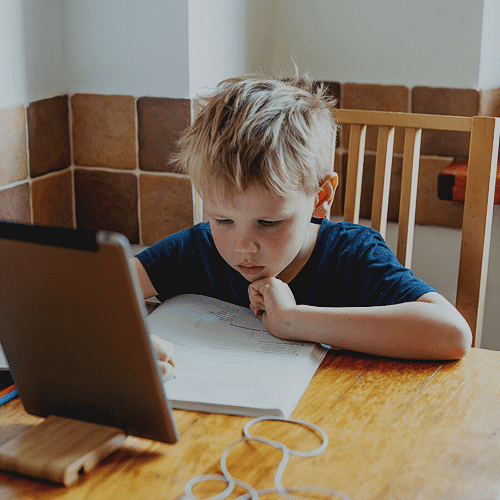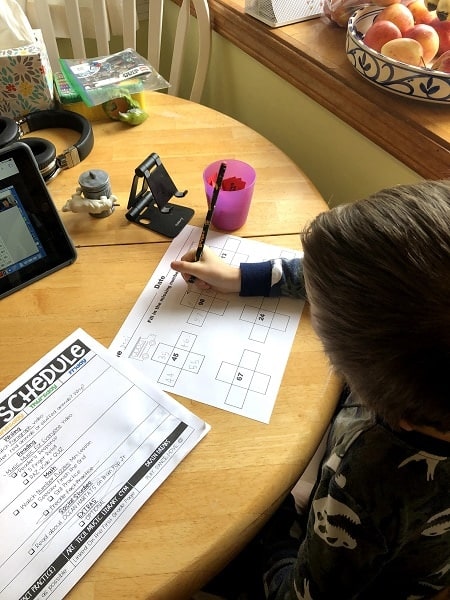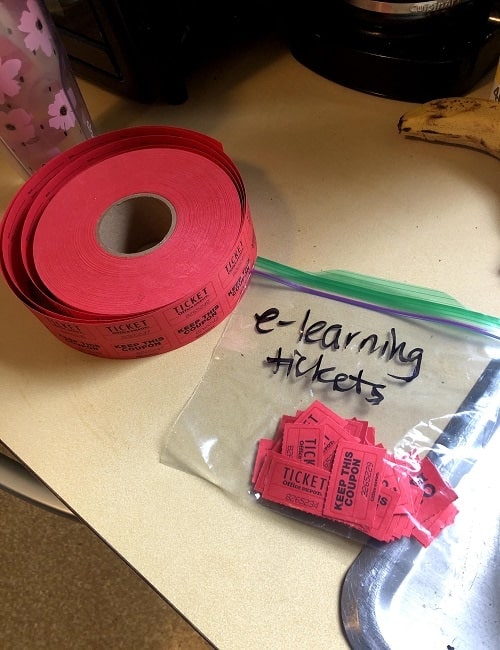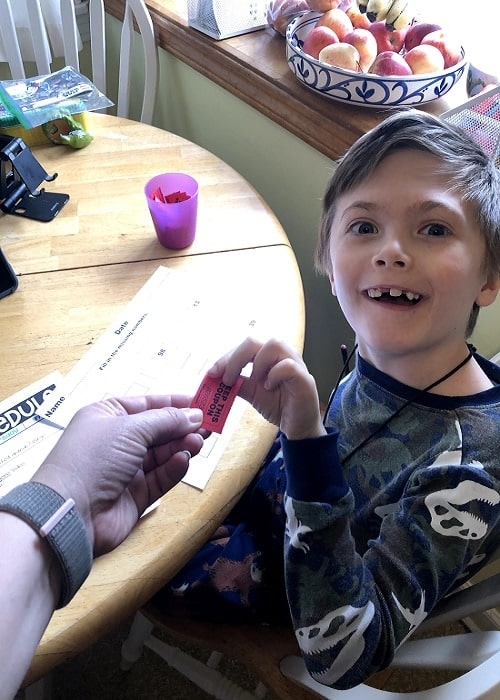Last updated on February 5th, 2024 at 05:09 pm
Congratulations, you’ve been promoted! Now, there’s no raises, no bonuses, and no sweet company car, and you’ll definitely be doing this new full-time job alongside your ALREADY FULL-TIME job. Yup, you guessed it! You’ve been promoted to co-teacher at your own home! Welcome to the wonderful world of distance learning!
OK, so we’ve all been there. The spring of Corona was a hot mess and all parents and teachers around the world were scrambling to move the school into the home through the internet. Many lessons were learned, many tears were shed, and I bet some of those tears were your own! (Am I right?) But this year is going to be better because we’re going to be prepared.
Feeling a little down during COVID? See why one twin mom reminds herself to laugh every day.
We had our very own high school teacher/twin mom Crystal Duffy offer up her best advice to start this new school year from home on the best foot forward. Crystal simultaneously taught her high school English classes online while serving as a “co-teacher” for her three girls at home, so we consider her the expert on distance learning. We hope with these tips you’ll have a little less pain and a little more optimism about the new socially-distant school year.

1. Stay Positive During Distance Learning
Regardless of whether or not you agree with your child’s school’s re-entry plan for the fall, be positive. Put on a happy face in front of your children. Get excited! Go back-to-school shopping for supplies and clothes like you would do every year. Even if you are angry, upset, and anxious with the school’s plan, wait until your kids go to bed and vent with a partner or friend.
Be strong and put on your best face in front of your children regarding their education. The last thing you would want to do is contribute to your child’s anxiety. Your attitude will influence your child’s attitude, learning, and development this year. In order to ensure success, be positive and supportive so you can get through this together.

2. Plan and Create Your Learning Space
Plan and create your space for distance learning. Does your kiddo have a special place they do homework? Do they work in their bedroom? Dining room table? It’s important wherever you set up your workspace to make sure it is quiet, clutter-free, and avoids any distractions. Reducing clutter helps kids concentrate and focus! Avoid areas near the TV and high traffic areas in your home. If your kids are older and will be doing work on their own, make sure you’re close enough so you can hear what’s going on.
If you don’t have an obvious spot, consider doing a little temporary redecorating. Run to Target or Walmart, get a folding table, and simple comfy chairs. Also, check out the dollar store for organizational bins for paper, pencils, and crayons. Provide a bin for each child to keep their personal folders, books, and materials and encourage them to decorate it to make it their own.

Need a good laugh to get you through the pandemic and distance learning? Don’t miss this post to get you smiling!
3. Set Routines for Distance Learning
Children, especially young children, thrive on routines. As educators, we create routines with our students on Day 1. There are clear school start times and end times, but with no school bell to mark kids tardy, we (parents included) might feel like sleeping in. With no set schedule, kids won’t start schoolwork in a timely manner. To ensure successful learning this requires ahead of time planning. What is your family’s schedule and what are the best times for learning?
Download a PRINTABLE blank schedule for distance learning

Invest in a dry erase board to write out the distance learning schedule each day. If you give your kids a set schedule for “school time” they are more likely to go along with it. This is what they’re used to doing in school. Set a start time and end time as well so you all have a goal to meet, whether you finish everything or not. This will help things to move along and not take up the whole day.
Some things to consider: young children are more alert and work better in the mornings. If you have a middle schooler or high schooler, late afternoon and early evening might be when they are most awake and ready to learn. Build in some “brain breaks,” where you go for a walk as a family or just get up out of your chair and move around for a few minutes. Also, it’s okay to build in some screen time and TV time during the day; just make sure to identify what time of day your child learns best and stick with it.

4. Set Expectations for Distance Learning
Worried about how you’ll manage distance learning? Read some of our common distance learning fails to help you avoid them this year!
As educators, we have high expectations for our students. As parents, we need to also have high expectations for our children as our students. Have a conversation with your children ahead of time. Explain what distance learning is going to look like in your house. Explain that this is real school work, it needs to be taken seriously, and it will be graded by their teachers.
Feeling a bit let down by your expectations during the pandemic? One twin mom suggests lowering your expectations to save your sanity!
Setting up the expectations from day one will help avoid meltdowns and tantrums later on. Additionally, consider having extra work available to supplement some of your children’s assignments. Find assignments they can work on independently and don’t need your help with as much (reading a book and writing a short report is a good option). Setting the academic bar high and having the kids get used to doing independent practice where you are not guiding them the entire time will be beneficial for both children and parents.
That said, give yourself the OK for it to be a train wreck at times. You are going to have plenty of distance learning fails, but also a lot of successes. Go into it assuming that it won’t be perfect and it’s not always going to be what’s best for your child. Keep in close communication with your child’s teacher if you start to notice problems so you can all work it out together before a big blowup.

5. Consider a Token System to Motivate
If you need extra motivation to get your kids to finish their work, look into setting up a token system. This could be tickets, coins, or any other kind of token that symbolizes a reward. Hand these out one at a time whenever you see positive behavior, such as sitting correctly in a chair to work, finishing a worksheet, watching an instructional video in full, etc.

Worrying about how you will get through all of this? See why Twiniversity founder Natalie Diaz says she knows we’re all gonna be ok.
Keep the tokens flowing in the beginning and you’ll soon see improvements in good behavior. Do not give demerits or take away tokens for bad behavior. Just don’t give out more tokens until you see good behavior again. As time goes by, the tickets become a little more challenging to earn and you don’t dole them out as generously.
Tokens can be traded in for anything your kids like, but talk to your kids to find out what they value the MOST. For example, credit to the App Store, a visit to the ice cream shop, getting to choose the family movie of the week, or a special toy. The higher value the prize (in their eyes) the more motivated they’ll be to get the work done. Make a list of items in the “store” that can be bought with the tokens. Decide the value of tickets for each item, like you’re running your own arcade. Buy some lower value items too, such as fun-size candy bars, dollar store toys, etc.
Don’t miss out on a new post again by subscribing to Twiniversity’s email list here!

Technology and Distance Learning
Technology is our best friend (and our enemy at times, haha). When your school releases their re-entry plan, identify what online platforms will be utilized, and determine whether the instruction will be asynchronous or synchronous.
Asynchronous is when the teachers pre-record videos ahead of time and upload them so anyone can access them at any time throughout the day. Synchronous instruction means lecture or class discussion in real-time. This live instruction can be done through video conferencing such as Zoom or Microsoft Teams. Print a handout for your family that includes all the meeting days and times and any meeting codes or passwords necessary to log in and teach your child how to log into their meetings with their teacher.
There are benefits to having twins during the pandemic. Read about them here.
When your school sends out a list of websites and resource videos it’s important to not get overwhelmed by the long list. Peruse, peruse, peruse. Take a few minutes a day to play around with a couple of sites and identify the potential uses (or not) for your child.

YouTube videos are a great resource. If you want to find out more about a specific platform, chances are there are tons of great explanatory videos on YouTube that give a great rundown of what the website is and what the benefits are. What’s great about this is that you can listen and multitask while you are doing housework or something else. Once you are done exploring the list of resources, pick your favorite three, and identify those as the ones you and your family will use.
What is going to make for a successful year of distance learning is for all of us – teachers, administrators, parents, and students – to have a lot of patience. This includes patience for the teacher creating the most effective lesson transferred online, patience for the parents to figure it out, and patience for the children to complete it all. This will be a challenging year but I believe there are some positive aspects to come out of distance learning that have the potential to really impact the educational system in our country. Here’s to a great start to the school year!

Crystal Duffy lives in Houston with her husband, three little girls, and a yappy little Yorkie. Her writing has appeared in Twins Magazine and Mamapedia. She’s currently working on her memoir Twin to Twin which details her high-risk twin pregnancy. Connect with her on her blog.







